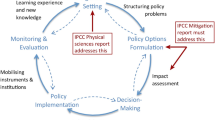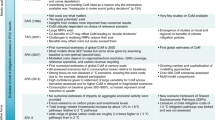Abstract
Jurisdictions worldwide increasingly affirm their contributions to the Paris Agreement by pledging net-zero targets. We argue that delivering on net-zero targets compels a backward induction approach to climate policy, which stipulates that maximizing credibility should be the objective of policy pathways design. This implies choosing policies that strike a suitable balance between building commitment and attaining cost efficiency. Our argument rests on the premise that private investments play a key role for net zero, and that getting expectations right—through credible commitment to a policy pathway—is more relevant than getting the prices right to align the investments with net zero. We sketch the main elements for a regulatory strategy to put this approach into action.
This is a preview of subscription content, access via your institution
Access options
Access Nature and 54 other Nature Portfolio journals
Get Nature+, our best-value online-access subscription
$29.99 / 30 days
cancel any time
Subscribe to this journal
Receive 12 print issues and online access
$209.00 per year
only $17.42 per issue
Buy this article
- Purchase on Springer Link
- Instant access to full article PDF
Prices may be subject to local taxes which are calculated during checkout


Similar content being viewed by others
References
Paris Agreement to the United Nations Framework Convention on Climate Change TIAS no. 16-1104 (US State Department, 2015).
Lang, J. et al. Net Zero Tracker (Energy and Climate Intelligence Unit, Data-Driven EnviroLab, NewClimate Institute, Oxford Net Zero, 2021).
Rogelj, J. Net zero targets in science and policy. Environ. Res. Lett. 18, 021003 (2023).
Drouet, L. et al. Net zero-emission pathways reduce the physical and economic risks of climate change. Nat. Clim. Change 11, 1070–1076 (2021).
Goulder, L. H. Timing is everything: how economists can better address the urgency of stronger climate policy. Rev. Environ. Econ. Policy 14, 143–156 (2020). A call for economists to acknowledge the urgency of climate change and the relevance of timing, and suggestions for how to better address it in research.
Pisani-Ferry, J. Climate Policy Is Macroeconomic Policy, and the Implications Will Be Significant (PIIE, 2021).
Edvardsson, K. & Hansson, S. O. When is a goal rational? Soc. Choice Welf. 24, 343–361 (2005).
Victor, D. G., Lumkowsky, M. & Dannenberg, A. Determining the credibility of commitments in international climate policy. Nat. Clim. Change https://doi.org/10.1038/s41558-022-01454-x (2022).
Cullenward, D. & Victor, D. Making Climate Policy Work (Wiley & Sons, 2020).
De Chiara, A. & Schwarz, M. A. A Dynamic Theory of Regulatory Capture Working Paper No. 8968 (CESifo, 2021); https://doi.org/10.2139/ssrn.3815456Account of the political challenges of long-term climate policies, including a critical discussion of market-based policies to catalyse transformation.
Gersbach, H. & Glazer, A. Markets and regulatory hold-up problems. J. Environ. Econ. Manage. 37, 151–164 (1999).
Tavoni, A. & Winkler, R. Domestic pressure and international climate cooperation. Annu. Rev. Resour. Econ. 13, 225–243 (2021).
Petit, M. L. Control Theory and Dynamic Games in Economic Policy Analysis (Cambridge Univ. Press, 1990). Textbook on dynamic game theory that formally, yet in an easily accessible way, establishes the problem of time inconsistency and why it arises.
Vogt-Schilb, A., Meunier, G. & Hallegatte, S. When starting with the most expensive option makes sense: optimal timing, cost and sectoral allocation of abatement investment. J. Environ. Econ. Manage. 88, 210–233 (2018).
Brunner, S., Flachsland, C. & Marschinski, R. Credible commitment in carbon policy. Clim. Policy 12, 255–271 (2012).
Fankhauser, S. et al. The meaning of net zero and how to get it right. Nat. Clim. Change 12, 15–21 (2022).
Nemet, G. F., Jakob, M., Steckel, J. C. & Edenhofer, O. Addressing policy credibility problems for low-carbon investment. Glob. Environ. Change 42, 47–57 (2017). One of the first articles to highlight the importance of policy credibility for climate change and systematically infer lessons from other fields.
Kydland, F. E. & Prescott, E. C. Rules rather than discretion: the inconsistency of optimal plans. J. Political Econ. 85, 473–491 (1977).
Dellas, H. & Tavlas, G. S. Retrospectives on the evolution of the rules versus discretion debate in monetary policy. J. Econ. Perspect. 36, 245–260 (2022). Review of the scientific developments and insights in the field of ‘rules versus discretions’ since its inception in the 1970s.
Cukierman, A. & Meltzer, A. H. A theory of ambiguity, credibility, and inflation under discretion and asymmetric information. Econometrica 54, 1099 (1986).
Blinder, A. S. Central bank credibility: why do we care?. Am. Econ. Rev. 90, 1421–1431 (2000).
Meckling, J., Sterner, T. & Wagner, G. Policy sequencing toward decarbonization. Nat. Energy 2, 918–922 (2017).
Pahle, M. et al. Sequencing to ratchet up climate policy stringency. Nat. Clim. Change 8, 861–867 (2018). The sequencing framework establishes a general approach for how to incrementally overcome barriers to stringency over time, to which this work connects by establishing complementary overall pathway criteria.
Fuest, C. & Meier, V. Sustainable finance and climate change: wasteful but a political commitment device? J. Environ. Econ. Manage. 118, 102795 (2023).
World Energy Outlook 2021 (IEA, 2021).
Net Zero Financing Roadmaps (Race to Zero, 2021).
Sinn, H.-W. The Green Paradox: A Supply-Side Approach to Global Warming (MIT Press, 2012); https://doi.org/10.7551/mitpress/8734.001.0001
Michielsen, T. O. Brown backstops versus the green paradox. J. Environ. Econ. Manage. 68, 87–110 (2014).
Beckert, J. Imagined Futures: Fictional Expectations and Capitalist Dynamics (Harvard Univ. Press, 2016).
Jacobs, A. M. Policy making for the long term in advanced democracies. Annu. Rev. Political Sci. 19, 433–454 (2016). Broader overview of the general challenges for long-term policy in democracies.
Ekeland, I. & Lazrak, A. The golden rule when preferences are time inconsistent. Math. Financ. Econ. 4, 29–55 (2010).
Sabel, C. F. & Victor, D. G. Fixing the Climate (Princeton Univ. Press, 2022).
Bellman, R. Dynamic Programming (Princeton Univ. Press, 1957).
den Haan, W. Notes on Dynamic Optimization Problems Ch. 1 (wouterdenhaan, accessed 1 August 2023); http://www.wouterdenhaan.com/teach/ch1.pdf
Acemoglu, D., Aghion, P., Bursztyn, L. & Hemous, D. The environment and directed technical change. Am. Econ. Rev. 102, 131–166 (2012).
Meckling, J., Kelsey, N., Biber, E. & Zysman, J. Winning coalitions for climate policy. Science 349, 1170–1171 (2015).
Pahle, M. et al. Safeguarding the energy transition against political backlash to carbon markets. Nat. Energy 7, 290–296 (2022).
Goulder, L. H., Hafstead, M. A. C. & Williams, R. C. III General equilibrium impacts of a federal clean energy standard. Am. Econ. J. Econ. Policy 8, 186–218 (2016).
Goulder, L. H., Hafstead, M. A. C. & Williams, R. C. III The Building Storm: Tax, Fiscal & Social Policy (ATPI, 2023).
Harstad, B. Technology and time inconsistency. J. Political Econ. 128, 2653–2689 (2020).
Gerlagh, R. & Liski, M. Consistent climate policies. J. Eur. Econ. Assoc. 16, 1–44 (2018).
Dengler, S., Gerlagh, R., Trautmann, S. T. & van de Kuilen, G. Climate policy commitment devices. J. Environ. Econ. Manage. 92, 331–343 (2018).
Jenkins, J. D., Farbes, J., Jones, R., Patankar, N. & Schivley, G. Electricity transmission is key to unlock the full potential of the Inflation Reduction Act. Zenodo https://doi.org/10.5281/zenodo.7106176 (2022).
Grey, F. Corporate lobbying for environmental protection. J. Environ. Econ. Manage. 90, 23–40 (2018).
Carlson, B. & Burtraw, D. Lessons from the Clean Air Act: Building Durability and Adaptability into US Climate and Energy Policy (Cambridge Univ. Press, 2019).
Fietze, D., Kröger, M., Müller, T. & Karsten, N. Ein wirksames Klimaschutzgesetz braucht Frühindikatoren Vol. 41 (DIW, 2021).
Duwe, M. Making EU Climate Governance Fit for Net Zero (Umweltbundesamt, 2022).
Annual Work Programme of the European Scientific Advisory Board on Climate Change for the Year 2022, Adopted on 28 June 2022 (EEA, 2022).
Sivaram, V., Bowen, M., Kaufman, N. & Rand, D. To Bring Emissions-Slashing Technologies to Market, the United States Needs Targeted Demand-Pull Innovation Policies. (Center on Global Energy Policy, 2021); https://www.energypolicy.columbia.edu/publications/bring-emissions-slashing-technologies-market-united-states-needs-targeted-demand-pull-innovation/
Gollier, C. & Tirole, J. Negotiating effective institutions against climate change. Econ. Energy Environ. Policy 4, 5–27 (2015).
Burtraw, D., Holt, C., Palmer, K. & Shobe, W. Price-responsive allowance supply in emissions markets. J. Assoc. Environ. Resour. Econ. 9, 851–884 (2022).
Aldy, J. E. et al. Resolving the inherent uncertainty of carbon taxes. Harvard Environ. Law Rev. Forum 41, 1–13 (2017).
Stern, N. Public economics as if time matters: climate change and the dynamics of policy. J. Public Econ. 162, 4–17 (2018). Elaboration of how public policy must be thought of and conceived when the pace and nature of change are critical to any serious policy assessment.
IPCC Climate Change 2022: Mitigation of Climate Change (eds Shukla, P. R. et al.) (Cambridge Univ. Press, 2022).
Fernandez-Villaverde, J. & Nuno, G. Dynamic Programming in Continuous Time (Univ. Pennsylvania, 2021).
Gavrilidis, K. Measuring Climate Policy Uncertainty (SSRN, 2021).
Goulder, L. H. & Parry, I. W. H. Instrument choice in environmental policy. Rev. Environ. Econ. Policy 2, 152–174 (2008).
Holland, S. P., Mansur, E. T. & Yates, A. J. The electric vehicle transition and the economics of banning gasoline vehicles. Am. Econ. J. Econ. Policy 13, 316–344 (2021).
Krueger, A. O. The political economy of the rent-seeking society. Am. Econ. Rev. 64, 291–303 (1974).
Green, F. The logic of fossil fuel bans. Nat. Clim. Change 8, 449–451 (2018).
Meckling, J. & Nahm, J. The politics of technology bans: industrial policy competition and green goals for the auto industry. Energy Policy 126, 470–479 (2019).
Yeh, S., Burtraw, D., Sterner, T. & Greene, D. Tradable performance standards in the transportation sector. Energy Econ. 102, 105490 (2021).
Transformation zu einer klimaneutralen Industrie: Grüne Leitmärkte und Klimaschutzverträge (Wissenschaftlicher Beirat BMWK, 2022).
Salant, S. W. What ails the European Union’s emissions trading system? J. Environ. Econ. Manage. 80, 6–19 (2016).
Pahle, M., Günther, C., Osorio, S. & Quemin, S. The emerging endgame: the EU ETS on the road towards climate neutrality. SSRN https://doi.org/10.2139/ssrn.4373443 (2023).
Acknowledgements
We gratefully acknowledge financial support from the Federal Ministry of Education and Research of Germany in the Ariadne project (03SFK5S0) and Resources for the Future Comprehensive Climate Policies Program. We are indebted to L. Goulder, G. Nemet, G. Perino and L. Stern as well as participants to the RFF Seminar Series for helpful comments on earlier versions of this paper. The views expressed in this paper are those of the authors and do not necessarily represent the views of the International Monetary Fund or its executive board or management.
Author information
Authors and Affiliations
Corresponding author
Ethics declarations
Competing interests
The authors declare no competing interests.
Peer review
Peer review information
Nature Climate Change thanks Alessandro Tavoni, Klaus Schmidt and the other, anonymous, reviewer(s) for their contribution to the peer review of this work.
Additional information
Publisher’s note Springer Nature remains neutral with regard to jurisdictional claims in published maps and institutional affiliations.
Rights and permissions
Springer Nature or its licensor (e.g. a society or other partner) holds exclusive rights to this article under a publishing agreement with the author(s) or other rightsholder(s); author self-archiving of the accepted manuscript version of this article is solely governed by the terms of such publishing agreement and applicable law.
About this article
Cite this article
Dolphin, G., Pahle, M., Burtraw, D. et al. A net-zero target compels a backward induction approach to climate policy. Nat. Clim. Chang. 13, 1033–1041 (2023). https://doi.org/10.1038/s41558-023-01798-y
Received:
Accepted:
Published:
Issue Date:
DOI: https://doi.org/10.1038/s41558-023-01798-y



